
Jump to:
It may be fair to say that in the West, in particular, mold does not have a good rep. We think of it as something unwanted that forms on food when we don’t consume it quickly enough. Did you know, however, that a certain type of mold is the basis for several important elements of Japanese food and drink? This ranges from Shoyu (Japanese soy sauce) and other Hakko Shokuhin (fermented foods) to Japanese liquor, such as Nihonshu (commonly known as “sake”), Shochu, and Awamori.
We are referring to Koji. This is rice or beans that have been inoculated with a special type of fungus. In this article, we will look at what it is, its history, the different strains, health benefits, the way that it is used in food production, and the means of purchasing and using it in your own cooking.
What Is Koji?

Koji is the name of the fungus used to make Koji mold. This type of mold is found only in Japan and other humid East-Asian and South-East Asian countries. Due to its wide usage in various foods and drinks, it has achieved the status of being Japan’s national fungus.
Koji mold produces many enzymes for softening ingredients and bringing out the flavor and sweetness of fermented foods, including protease, which breaks proteins into amino acids, amylase, which breaks down starches into sugars, and lipase which breaks down fats.
Koji bacteria are not used as is but are added to rice, barley, soybeans, and the like. and cultivated into use as Koji. The type of Koji produced will vary depending on what kind of ingredients, or culture medium, are used to propagate the fungi, such as "rice koji," "barley Koji," or "soybean Koji.
History of Koji
So how did Japanese people start using Koji? Although it is thought that the practice of producing Koji began in China more than 2,000 years ago, it seems that its first appearance in a historical book was at the beginning of the 8th century, in the Nara period (710-794). During this period, a book called "Harimakuni Fudoki" described the fact that "dried rice was wet and mold was growing on it, and this was used to make sake.” Later, in the Muromachi period (1333-1573), powdered “Koji dust” was developed, in which only the spores were collected.
During the Edo period (1603-1867), the general public began to experience the benefits of Koji in the form of Amakoji (which forms the basis of Amazake) and this gained notoriety as a defense mechanism against the summer heat. It was not until the Meiji era (1868-1912), however, that it began to be sold to the general public, as before that its production and sale had been monopolized by a group of people called “Koji-shu”. In 2006, Koji was recognized as the “national fungus”.
Different Strains Of Koji

Although you may have heard that Koji is used to create a variety of types of fermented food and alcohol, you may not know that there are different strains of Koji, and that different types are used depending on the desired effect. The main types discussed here are white, yellow, and black Koji.
Yellow Koji (Aspergillus Oryzae) has a lighter taste because it does not produce citric acid. It is used not only for Nihonshu, but also for miso and soy sauce. It produces potent enzymes that saccharify starch and break down proteins.
Black Koji (Aspergillus Awamori) is primarily used in the production of Awamori, a distilled Okinawan spirit with a single fermentation. It is characterized by its high production of citric acid and is also used in some varieties of Shochu and Nishonshu.
White Koji (Aspergillus Kawachi) is a mutant form of black Koji used mainly in the production of Shochu. It is characterized as having a lighter acidity than black Koji.
As described above, although in simplistic terms, white Koji is used for Shochu, yellow Koji is used for Nihonshu, and black Koji is used for Awamori, you can also find Shochu that uses yellow or black Koji, and Nihonshu that uses black Koji, so it may be fun to try each and compare the difference in taste produced by each.
Some other minor types of Koji are red Koji used for Laochu (Chinese liquor), and Katsuobushi bonito mold which is used for the production of dried bonito flakes.
Does Koji Have Any Health Benefits?

The enzymes produced by Koji bacteria break down starch and protein in food, allowing for efficient digestion and absorption in the body. The oligosaccharides produced by the enzymes activate the good bacteria in the gut, thus improving the intestinal environment. Additionally, Koji mold produces an abundance of vitamins, minerals, and other nutrients, and is said to be effective for fatigue recovery and the promotion of beauty.
Koji also contains an abundance of beta-glucans. Beta-glucans are soluble fibers found in the cells of certain types of yeast, bacteria, and fungi. They are associated with multiple health benefits including lower cholesterol levels and an enhanced immune system through the production of macrophages. It also contains glycosylceramide, which improves the condition of the skin and causes the proliferation of intestinal microbial flora.
Finally, the fermentation of soya beans using koji to create miso is known to increase the levels of isoflavones, which are compounds that are said to be effective in the prevention of cancer.
How Is Koji Used In Food And Drink

As mentioned previously, Koji is used in the production of the three main traditional Japanese liquors: Nihonshu, Shochu, and Awamori. It is also used for condiments, such as Shoyu, miso paste, Osu (rice vinegar), Mirin, and Kurosu (black rice vinegar), soy-based fermented foods, such as miso paste and natto, and various other fermented food and drink, such as Amazake.
The first step is to make the Koji itself. This involves adding the relevant Aspergillus culture to the raw material to be fermented. This can be steamed rice, soybeans, or in the case of Shoyu, this is a mixture of steamed soybeans and roasted wheat. The resulting mixture is then placed in a warm and humid place for up to 50 hours in wooden trays (Koji Buta). During this time, the particular type of Aspergillus used feeds on the rice, etc., and breaks down the proteins and carbohydrates in the raw ingredient into sugars and amino acids, respectively, through the activity of various enzymes.
The Koji, after it has been created, is usually added to larger quantities of the raw ingredient along with a brine solution. The enzymes in the Koji then break down the raw ingredients into amino acids, fatty acids, and sugars. In the case of alcohol, such as Nihonshu, yeast is also added to the fermentation process.
In the last section, we discussed the health benefits of Koji, but did you know that Koji is also responsible for the savory taste of umami, a Japanese culinary term that has recently entered English parlance? This is the delicious and intensely satisfying savory taste found in fermented foods, and glutamate, one of the amino acids released through the fermentation effects of Koji is what gives foods their umami punch.
Can I Buy And Use Koji Myself?
As detailed so far in this blog post, we can see the workings of Koji in many of the food and drink commonly enjoyed in Japan. You may be wondering whether it is possible to buy Koji and use it yourself in your cooking?
There are two main types of koji: raw Koji and dried Koji. Generally, when we speak of Koji we are referring to raw Koji. Although raw Koji is more powerful, it has a shorter shelf life due to the fact that the koji bacteria in raw Koji are still alive and are vulnerable to other bacteria. In addition, the quality of the Koji can easily deteriorate due to self-fermentation. Dried Koji is made by extracting water from raw Koji and then drying it. This makes it resistant to bacteria and self-fermentation can also be suppressed enabling it to be stored for a longer period of time. It is said to have the same taste and nutritional value as fresh koji.
With the recognition of the health benefits of Koji, both raw Koji and dried koji have become readily available in supermarkets, but perhaps online shopping is the best way to find Koji that meets your individual purpose. You can also purchase it at specialty shops and miso shops.
Cooking With Koji

So, once you have purchased Koji, what can you do with it? As stated earlier, Koji brings out the umami in dishes, so try using it for marinating and flavoring proteins, exchange it for the soy sauce in your stir-fries, add it to miso soup, or even use it to dry-age beef.
Despite essentially being a mold, Koji is safe to eat as is, and people are doing this more and due to its renowned health-giving properties. In fact, its safety has been certified by the U.S. Food and Drug Administration.
Its texture is similar to rice cooked to a firm consistency, and it has a delicious taste with a hint of sweetness.
How Long Can I Store Koji?
Dried Koji can be stored at room temperature. It depends on the product, but in most cases, it can be stored for 3 to 5 months. Store it in a cool, dark place or refrigerate in the summer. As it is dried, it can easily absorb moisture, so it is best to store it in an airtight container to prevent moisture absorption.
Since raw Koji is "live" Koji, it should be stored in the refrigerator to preserve its quality. This will enable the Koji to retain its strength and allow it to be stored for about 3 weeks. In the freezer, it can be stored for about 3 months. If Koji is mixed with salt, it can be stored for as long as four months at room temperature, while retaining the quality of the koji. However, you should note that once salt is mixed in, it cannot be used to prepare Amazake and other drinks that do not use salt.
Koji – The Versatile And Super-Useful Mold

As described in this article, Koji is a deeply ingrained and essential part of Japanese food and drink culture. It is responsible for the three main types of Japanese liquor and is an essential part of the process of fermenting foods, such as Miso, and condiments such as Soy Sauce.
Koji not only provides health benefits, such as aiding digestion by improving and maintaining the intestinal flora environment, but we also have to thank it for the highly satisfying Umami taste in food, which it achieves by breaking down proteins into the amino acid glutamate.
In addition to being an essential ingredient in many of the foods we enjoy on a daily basis, you can also purchase Koji in its dry or raw form for use in your own cooking.
Have you ever bought and used Koji yourself in the kitchen? Let us know in the comments.


0 comments